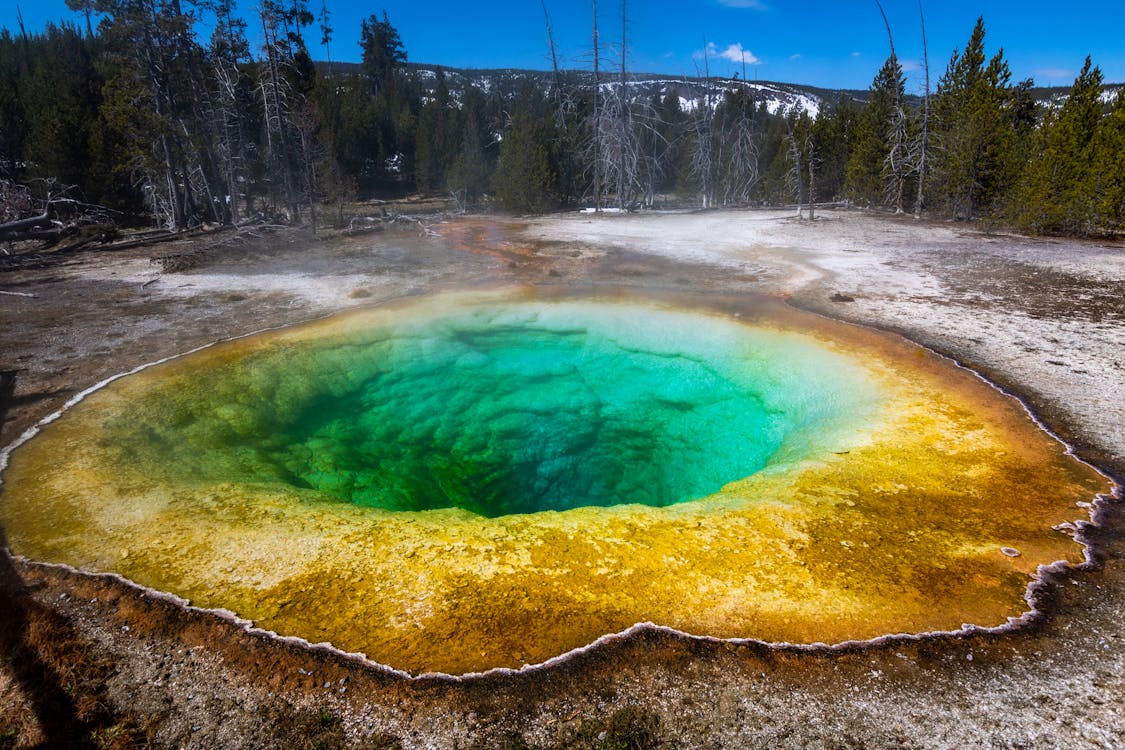Hiking Yellowstone National Park: Must-See Trails and Wildlife


Yellowstone National Park is a unique over 2.2-million acre destination, as Yellowstone is located mostly in Wyoming, but extends into Montana and Idaho. Often mentioned as the world’s first national park, Yellowstone impresses the visitors through geysers, canyons and great wildlife. Old time hiker, weekend explorer or just an occasional nature freeway traveler, you will find the Park and its fantastic trail worthy your visit.
Getting to Yellowstone

The routes are North through Gardiner Montana, Northeast through Cooke City Montana, East through Cody Wyoming, South through Jackson Wyoming and West through West Yellowstone Montana.
- Closest Airports: Other airports easy to access by air include the Bozeman Yellowstone International Airport also be called bzn, Jackson Hole Airport known as jac andYellowstone Regional Airport, cod.
- Driving Distances: A journey through the park is also easily possible from Bozeman because the North Entrance is only a 1.5-hour drive. Jackson offers spectacular views and it is approximately 2 hours drive to South Entrance of the park.
Must-See Hiking Trails
Yellow Stone National Park is a hiker’s delight provided with more than 900 miles of trails seeming different from each other. It is true that you do not have to be a hiker to enjoy Yellowstone’s scenic beauty sights and you do not have to be a moderate hiker to enjoy a tour whereby you get to hike to a certain spot. Here’s a closer look at some of the park’s standout trails:
Lamar Valley Trail
Lamar Valley Trail: This is a 5 miles loop trail that offers a great glimpse into one of the Yellowstone's famed wildlife solutions. Located near spectacular topography of rolling grasslands and awe-inspiring mountaintops, for the nature-lover and photographer this trail is preferable.
- Wildlife Spotting: There is an amazing number of animals within the valley. Although it is the home of bison where they have been living in the meadows and we only see them from far away when eating you can also spot elks and pronghorn antelope from far away. Other fauna like wolves and bears are also around but are considerably more difficult to photograph due to the amount of luck and time needed to find them.
- Best Times to Visit: Many animals come out during the early morning and late evening therefore you should hike during any of these times. Sometimes it becomes very beautiful since the light is not so bright at those times of the day.
- Trail Details: This trail is relatively easy; it can be used by hikers who do not intend to hike rigorously for any challenging purpose, families included. Still, always take bear spray since it goes without saying that this place is a bear country.
Geyser Hill Loop
This nature trail spans 1.5 miles in a circular path and you will find it within the Upper Geyser Basin–Yellowstone’s most prominant geothermal region. The trail presents a relatively easy, two-mile walking tour of a geothermally active environment, thus ideal for an initial orientation to the park.
- What to See: The trail runs along erupting geysers, steaming fumaroles, and bright hot pools. One of the things that make this park stand out is the Morning Glory Pool, a hot spring whose coloration goes from deep blue right through the spectrum to yellow due to thermophilic bacteria.
- Iconic Old Faithful: Because this trail begins near to Old Faithful, it will be possible to organize the hike so as to view the geyser eruption; the time interval for eruption is 1¾ hours.
- Accessibility: These trails can easily be described to be well maintained with boardwalks thus making it a very simple walk for people of all ages and all types of disability. One must not be tempted to walk off the trails, lest the Impacts detrimental to the geothermal and the common gains of all individuals be incurred or fatal accidents be endured.
Fairy Falls Trail
The Fairy Falls Trail is a five miles round trip and the trail leads to one of the fairy efficient waterfalls in Yellowstone. The tumbling 200-foot wall of waterfalls abruptly into a clear pool, which attracts hikers and photographers.
- The Journey: The trail is also fairly short beginning just north of the Midway Geyser Basin which is mainly level and trekking through a forested area before the first glimpse of the falls.
- Bonus Viewpoint: A short side trail before the bridge takes the visitor to a viewing platform of Grand Prismatic Spring. As seen from above this large hot spring deploys a fantastic color and from the specified angle offers one of the major photographic opportunities in the park.
- What to Bring: Wear sturdy hiking shoes, as the path can be uneven in places. Bring water and snacks to enjoy while admiring the falls.
Storm Point Trail
The short 2.3 miles Storm Point Trail is an accessible loop situated around the Yellowstone Lake with numerous options for forest trails and wildflower meadows and the beautiful lake views. This trail can be recommended to those tourists who want to avoid many other people and enjoy the views around.
- Lake Views: The trail comes out on a nice sandy shoreline that fronts the Yellowstone Lake – the highest empty lake in North America. The huge water teamed with mountains around makes it serene and magnificent.
- Wildlife Encounters: During the hike you will be able to witness marmot basking at rocks or birds gracefully swimming across the lake. Look for the great bald eagles flying above you.
- Trail Highlights: Even within the sections of the trail that passes through the forest there are thickets that provide cover and from which you may get to view different plants since some trees produce both roots and elaborated leaves.
These trails which range from easy to moderate will cover each aspect of Yellowstone including geothermal sites, wildlife valleys and water falls. This means that whichever you opt for, each one of these trails presents an opportunity to touch nature in this colossal and famous national park.
Tips for Planning Your Hike

- Timing: It is recommended to visit the park during summer and early fall because it is dry and the trails are accessible during June- September. However, these months tend to attract large numbers of people so it is advisable to begin hiking as early as possible in the morning.
- Permits: Permits are needed for backcountry camping and they can be obtained at the website or from the rangers.
- Trail Conditions: Note that some of the trails could be shut for some time due to weather conditions or animal movement. The information can be obtained at the official website of Yellowstone National Park or at any of the centers for visitors.
- What to Pack: A few must-haves for hiking are strong shoes, a map, water and food, and even sunscreen and bear repellent are recommended and not forgetting clothing, particularly in unpredictable climate conditions.
Yellowstone’s Abundant Wildlife
That is why one of the most attractive things about hiking in Yellowstone is the possibility to meet great wildlife there. The park supports over 300 bird species, 67 mammals species, and several amphibians and reptilians.
Lamar and Hayden Valleys are home to bison among a multitude of inhabitants typical for the park. Elk are also often seen especially during the period of the fall rum; the bugling calls can be heard in the valleys. Both black and grizzly bears inhabit Yellowstone Park, and therefore one has to be very cautious and always have bear spray with him/her. The elusive but commonly sighted species includes wolves, which might be observed in Lamar Valley at dawn or dust.
Smaller animals can also be found in Yellowstone’s waterways and forests, as well. River otters, beavers, and marmots are other inhabitants of the region, while bald eagles and osprey nest on trees. Always keep a safe distance between you and all the wildlife – at least 25 yards for most animals and 100 yards for bears and wolves.
Top Tips for a Successful Hike
There are advantages and disadvantages for hikers because Yellowstone is so different from trails in more temperate climates. To ensure a successful trip, follow these tips:
- Plan for varying weather conditions. In the cold season, it is still quite chilly in the evening while in the hot season, that is, summer it rains in the afternoons and early evenings.
- Start early. Mornings are certainly more favorable not only because everything is more silent, but also because mornings are cooler and the chances to meet wildlife are much higher.
- Stay on marked trails. Yellowstone has some of the most delicate ecosystems and thermal features making it very risky to go off trail.
- Leave no trace. Take all your litter with you, do not venture off trail, and always be proud of the park’s natural resources.
A Journey to Remember
It is not just walking on the trails in the park, traveling to Yellowstone National Park is the closest one can get to a nature-trekking adventure. Whether you are watching the geysers in the Upper Basin, standing at the rim of the Canyon in the central part of Yellowstone National Park, or watching wildlife in Lamar Valley, each trail has a story to tell about a landscape created by volcanic action, geothermal features, and glacier movement.
Yellowstone can be as simple as a casual stroll right up to a rugged hike on steep trails, all in one park. If planned well and accompanied with the feeling of great exploration the journey in this park will remain one of the best episodes in everyone’s story with nature.








